Related Research Articles

Rostanga is a genus of sea slugs in the family Discodorididae. Some sources, such as The Sea Slug Forum still classify Rostanga in the family Dorididae.

Booth Island is a rugged, Y-shaped island, 8 kilometres (5 mi) long and rising to 980 m (3,215 ft) off the northwest coast of Kyiv Peninsula in Graham Land, Antarctica in the northeastern part of the Wilhelm Archipelago. The narrow passage between the island and the mainland is the Lemaire Channel.
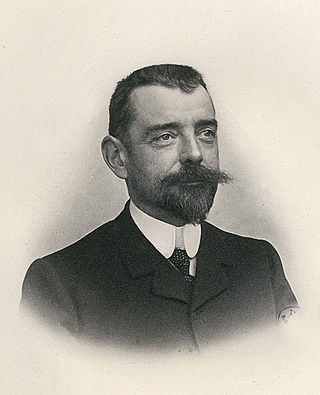
Louis Marie Adolphe Olivier Édouard Joubin was a professor at the Muséum national d'Histoire naturelle in Paris. He published works on nemerteans, chaetognatha, cephalopods, and other molluscs.
Curnonidae is a small family of sea slugs, nudibranchs, shell-less marine gastropod molluscs, in the clade Euthyneura.

Phyllidiopsis is a genus of sea slugs, dorid nudibranchs, shell-less marine gastropod molluscs and is the largest genus within the family Phyllidiidae.
Belaturricula gaini is a species of sea snail, a marine gastropod mollusk in the family Borsoniidae.
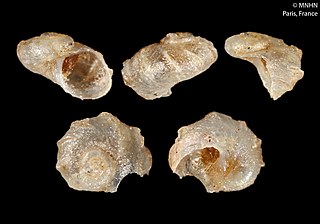
Scissurella petermannensis is a species of minute sea snail, a marine gastropod mollusk in the family Scissurellidae.

Chlanidota signeyana is a species of sea snail, a marine gastropod mollusk in the family Buccinidae, the true whelks. It was described by Harold Powell in 1951.

Pareuthria atrata is a species of sea snail, a marine gastropod mollusk in the family Cominellidae.
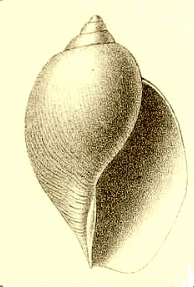
Harpovoluta charcoti is a species of sea snail, a marine gastropod mollusk in the family Volutidae, the volutes.
Émile-Eugène-Aldric Topsent was a French zoologist known for his research of sponges. He was born in Le Havre.
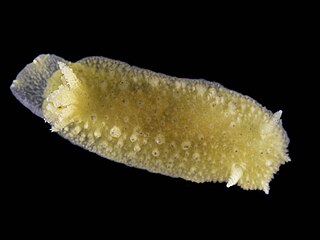
Doris ocelligera is a species of sea slug, a dorid nudibranch, a marine gastropod mollusk in the family Dorididae.

Turbonilla madrinensis is a species of sea snail, a marine gastropod mollusk in the family Pyramidellidae, the pyrams and their allies.
Albert Jean Baptiste Marie Vayssière was a French scientist, a biologist, specifically a malacologist and entomologist, i.e. someone who studies mollusks, and insects. Within the Mollusca, Vayssière specialized in sea slugs and bubble snails, i.e. marine opisthobranch gastropods. He made significant contributions towards a better understanding of the general biology, phylogenetic relationships, biogeography and ecological distribution of the group.
Goniodoris barroisi is a species of sea slug, a dorid nudibranch, a marine gastropod mollusc in the family Goniodorididae.
Knoutsodonta bouvieri is a species of sea slug, a dorid nudibranch, a shell-less marine gastropod mollusc in the family Onchidorididae.
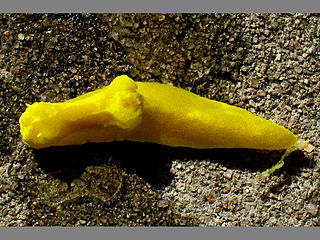
Aegires citrinus is a species of sea slug, a nudibranch, a marine, opisthobranch gastropod mollusk in the family Aegiridae.
Baeolidia macleayi is a species of sea slug, an aeolid nudibranch. It is a marine gastropod mollusc in the family Aeolidiidae.

Marseniopsis is a genus of small slug-like sea snails, marine gastropod molluscs in the subfamily Velutininae within the family Velutinidae.
Parmelia lambii is a species of foliose lichen in the family Parmeliaceae. It is found in the Antarctic Peninsula.
References
- ↑ Vayssière, A. J. B. M. 1906. Mollusques Nudibranches et Marséniadés. Expédition Antarctique Française (1903-1905). Commandee par le Dr. Jean Charcot. Sciences Naturelles: Documents Scientifiques, Mollusques, pp. 1-51, pls. 1-4.
- ↑ MolluscaBase (2019). MolluscaBase. Curnon granulosa (Vayssière, 1906). Accessed through: World Register of Marine Species at: http://www.marinespecies.org/aphia.php?p=taxdetails&id=1320723 on 2019-09-05
- ↑ Wägele, H., Barnes, D. K. A., and Bullough, L. W. (1995) Redescription of Charcotia granulosa Vayssière, 1906 (Nudibranchia: Arminoidea: Charcotiidae) from Signy Island, Antarctica. Journal of Molluscan Studies 61: 197-207.
- ↑ Rudman, W.B., 2007 (February 21) Charcotia granulosa (Vayssiere, 1906). [In] Sea Slug Forum. Australian Museum, Sydney.